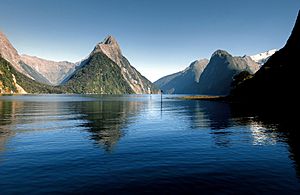List of fiords of New Zealand facts for kids

The fiords of New Zealand are incredible natural wonders. Imagine a long, narrow arm of the sea reaching far inland, surrounded by tall, steep cliffs. That's a fiord! These amazing places were carved out by huge glaciers moving slowly over thousands of years. When the glaciers melted, the sea filled these deep valleys.
Most of New Zealand's fiords are found in the southwest of the South Island. This mountainous area is even called Fiordland because of them! The Māori name for fiords is tai matapari, which means "bluff sea".
Even though they are true fiords, most of these places in New Zealand are called 'sounds' in their names. For example, the famous Milford Sound is actually a fiord.
You might also hear about the Marlborough Sounds in the north of the South Island. These are not true fiords. Instead, they are "rias," which are drowned river valleys. This means old river valleys were filled by the sea. Other rias can be found in Northland and Auckland, like the Hokianga and Waitematā Harbours.
New Zealand has fifteen named fiords along its coastline. They are listed below from north to south.
New Zealand's Coastal Fiords
Here is a list of the fifteen named fiords found along New Zealand's coast. They are listed from the northernmost to the southernmost.
| Name | Location | Length | Area |
|---|---|---|---|
| Milford Sound / Piopiotahi | 44°38′0″S 167°53′0″E / 44.63333°S 167.88333°E | 17.5 kilometres (10.9 mi) | 25.3 km2 |
| Te Hāpua / Sutherland Sound | 44°46′22″S 167°37′14″E / 44.77278°S 167.62056°E | 10 kilometres (6.2 mi) | 11 km2 |
| Hāwea / Bligh Sound | 44°47′4″S 167°30′28″E / 44.78444°S 167.50778°E | 18 kilometres (11 mi) | 21.1 km2 |
| Te Houhou / George Sound | 44°52′36″S 167°21′48″E / 44.87667°S 167.36333°E | 20.5 kilometres (12.7 mi) | 32.9 km2 |
| Taitetimu / Caswell Sound | 45°1′6.6″S 167°10′55.56″E / 45.018500°S 167.1821000°E | 15 kilometres (9.3 mi) | 17.5 km2 |
| Taiporoporo / Charles Sound | 45°5′0″S 167°6′49″E / 45.08333°S 167.11361°E | 14 kilometres (8.7 mi) | 15.9 km2 |
| Hinenui / Nancy Sound | 45°8′44.5″S 167°4′23″E / 45.145694°S 167.07306°E | 15 kilometres (9.3 mi) | 13.9 km2 |
| Te Awa-o-Tū / Thompson Sound | 45°13′27″S 166°58′16″E / 45.22417°S 166.97111°E | 18 kilometres (11 mi) | 28.4 km2 |
| Kaikiekie / Bradshaw Sound | 45°17′0″S 167°6′3″E / 45.28333°S 167.10083°E | 18.5 kilometres (11.5 mi) | 20.9 km2 |
| Doubtful Sound / Patea | 45°22′57″S 167°5′28″E / 45.38250°S 167.09111°E | 40 kilometres (25 mi) (to head of Hall Arm) | 83.7 km2 |
| Te Rā / Dagg Sound | 45°23′51″S 166°48′47″E / 45.39750°S 166.81306°E | 14 kilometres (8.7 mi) | 14.7 km2 |
| Te Puaitaha / Breaksea Sound | 45°32′52″S 166°52′22″E / 45.54778°S 166.87278°E | 30.5 kilometres (19.0 mi) | 61.5 km2 |
| Tamatea / Dusky Sound | 45°45′35″S 166°37′36″E / 45.75972°S 166.62667°E | 40 kilometres (25 mi) | 181 km2 |
| Taiari / Chalky Inlet | 46°0′54″S 166°34′50.52″E / 46.01500°S 166.5807000°E | 27.7 kilometres (17.2 mi) | 110 km2 |
| Rakituma / Preservation Inlet | 46°4′46.56″S 166°41′14.28″E / 46.0796000°S 166.6873000°E | 36.5 kilometres (22.7 mi) | 93 km2 |
Thompson Sound is interesting because it separates Secretary Island from the mainland. It also connects with Doubtful Sound and Bradshaw Sound further inland. The entrance to Bradshaw Sound is about 12 kilometers from the Tasman Sea, inside Doubtful Sound.
Lakes that are Fiords
Not all fiords are connected to the sea! Some lakes in the Fiordland and Otago regions are also found in valleys carved by glaciers. These are sometimes called freshwater fiords.
- Lake Te Anau has three western arms that are actually fiords. They are even named as such!
- Lake McKerrow, located north of Milford Sound, is a fiord whose mouth has filled up with silt over time.
- Lake Wakatipu is a large lake that fills a huge glacial valley.
- Other lakes in the far south of Fiordland that fill glacial valleys include Hakapoua, Poteriteri, Monowai, and Hauroko.
- Lake Manapouri also has fiord-like arms on its West, North, and South sides.

